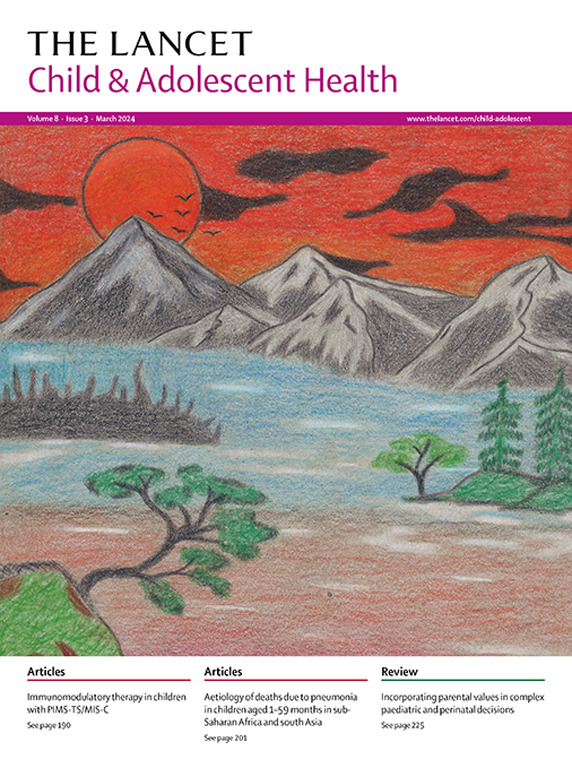Characteristics of children and adolescents with multidrug-resistant and rifampicin-resistant tuberculosis and their association with treatment outcomes: a systematic review and individual participant data meta-analysis
IF 19.9
1区 医学
Q1 PEDIATRICS
引用次数: 0
Abstract
Background
There are few data on the treatment of children and adolescents with multidrug-resistant (MDR) or rifampicin-resistant (RR) tuberculosis, especially with more recently available drugs and regimens. We aimed to describe the clinical and treatment characteristics and their associations with treatment outcomes in this susceptible population.
Methods
We conducted a systematic review and individual participant data meta-analysis. Databases were searched from Oct 1, 2014, to March 30, 2020. To be eligible, studies must have included more than five children or adolescents (0–19 years of age) treated for microbiologically confirmed or clinically diagnosed MDR or RR tuberculosis within a defined treatment cohort, and reported on regimen composition and treatment outcomes. Abstracts were screened independently by two authors to identify potentially eligible records. Full texts were reviewed by two authors independently to identify studies meeting the eligiblity criteria. For studies meeting eligiblity criteria, anonymised individual patient data was requested and individiual level data included for analysis. The main outcome assessed was treatment outcome defined as treatment success (cure or treatment completed) versus unfavourable outcome (treatment failure or death). Multivariable logistic regression models were used to identify associations between clinical and treatment factors and treatment outcomes. This study is registered with Prospero (CRD42020187230).
Findings
1417 studies were identified through database searching. After removing duplicates and screening for eligibility, the search identified 23 369 individual participants from 42 studies, mostly from India and South Africa. Overall, 16 825 (72·0%) were successfully treated (treatment completed or cured), 2848 died (12·2%), 722 (3·1%) had treatment failure, and 2974 (12·7%) were lost to follow-up. In primary analyses, the median age was 16 (IQR 13–18) years. Of the 17 764 (87·1%) participants with reported HIV status, 2448 (13·8%) were living with HIV. 17 707 (89·6%) had microbiologically confirmed tuberculosis. After adjusting for significant factors associated with treatment outcome, the use of two (adjusted odds ratio [OR] 1·41 [95% CI 1·09–1·82]; p=0·008) or three (2·12 [1·61–2·79]; p<0·0001) WHO-classified group A drugs (bedaquiline, moxifloxacin, levofloxacin, and linezolid) compared with the use of no group A drugs at all was positively associated with treatment success.
Interpretation
Younger and clinically diagnosed children are underrepresented among those treated for MDR and RR tuberculosis and should be a focus for case-finding efforts. Overall treatment outcomes in our analysis were better than in adults but lower than the international targets of 90% or more individuals successfully treated. Treatment with more group A drugs was associated with better treatment outcomes in children and adolescents, highlighting the need for more rapid access to these drugs and improved regimens.
Funding
Unitaid.
求助全文
约1分钟内获得全文
求助全文
来源期刊

Lancet Child & Adolescent Health
Psychology-Developmental and Educational Psychology
CiteScore
40.90
自引率
0.80%
发文量
381
期刊介绍:
The Lancet Child & Adolescent Health, an independent journal with a global perspective and strong clinical focus, presents influential original research, authoritative reviews, and insightful opinion pieces to promote the health of children from fetal development through young adulthood.
This journal invite submissions that will directly impact clinical practice or child health across the disciplines of general paediatrics, adolescent medicine, or child development, and across all paediatric subspecialties including (but not limited to) allergy and immunology, cardiology, critical care, endocrinology, fetal and neonatal medicine, gastroenterology, haematology, hepatology and nutrition, infectious diseases, neurology, oncology, psychiatry, respiratory medicine, and surgery.
Content includes articles, reviews, viewpoints, clinical pictures, comments, and correspondence, along with series and commissions aimed at driving positive change in clinical practice and health policy in child and adolescent health.
 求助内容:
求助内容: 应助结果提醒方式:
应助结果提醒方式:


